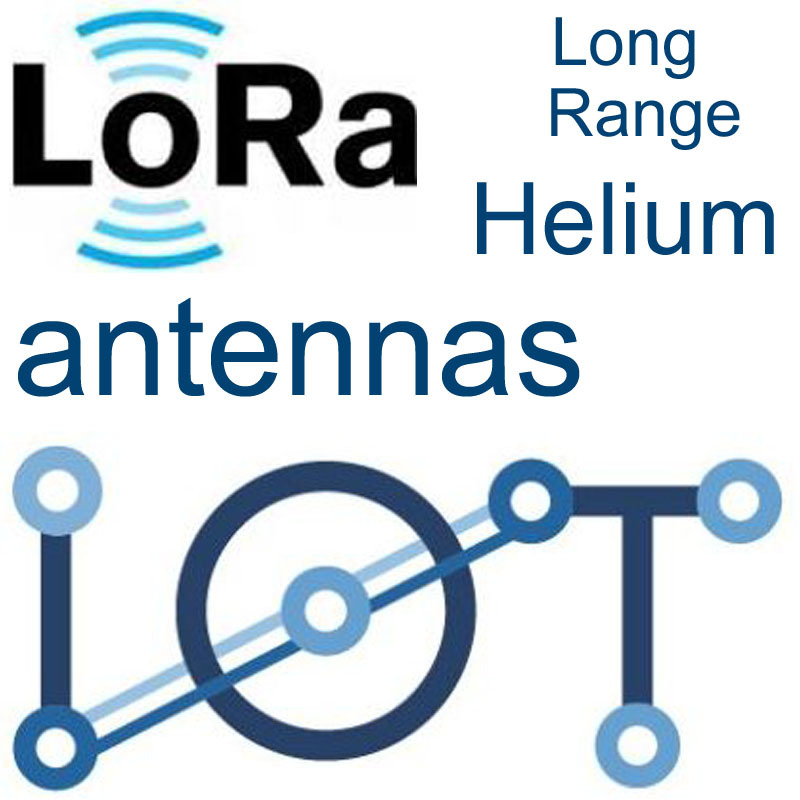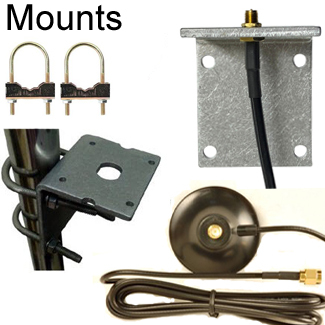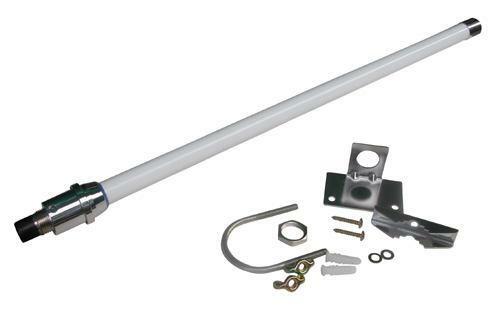LoRa / LoRaWAN Gear
LoRa Gateways: Key IoT Trend for 2022 and Beyond
LoRa, which stands for 'long range' is a type of Low Power Wide Area (LPWA) network that has demonstrated excellent performance in supporting IoT applications, particularly where IoT devices are battery-powered and transmit their data over long distances. LoRaWANs are set up and scaled by using a key network component known as a LoRa Gateway which transfers data bidirectionally between the IoT device and the LoRaWAN Network Server (LNS) or proprietary platforms that manage the data like The Things Network or AWS IoT Core for LoRaWAN.
Fiberglass antennas & window cables to mount your LoRaWAN antenna outdoors for longest range.
Acquisition of LoRa Gateways is a key mid-decade IoT trend.
As LoRa networking has become more widespread, there has been increasing demand for LoRa Gateways that can be used to build private or custom networks. Gateways are being set up by private individuals to provide publicly accessible LoRa networks, sometimes in return for cryptocurrency remuneration. This novel, decentralized method of providing large-scale LoRa network coverage across cities and regions is spearheaded by The Helium Network and is transforming LoRa Gateways into consumer products.
This article explains what LoRa gateways are and how these critical pieces of network hardware work within the LoRA system architecture. The effect of the LoRa antennas used with LoRa gateways on network performance is also explored briefly.
What is a LoRa gateway?
A LoRa Gateway is essentially a type of router that is able to concentrate acquired LoRa signals from IoT devices for forwarding to an internet based server. LoRa Gateways may also be called radios, concentrators or base stations.
LoRa Gateways are only able to receive LoRa data packets, and carry a highly sensitive antenna for this purpose. They collect and concentrate the low-power long-range, narrow-band LoRa signals and transfer them to the internet via high bandwidth networking technologies like WiFi or Ethernet and using TCP/IP. Within a network, one or multiple Gateways are capable of simply receiving and forwarding on the LoRa signals that they acquired. At the Network Server and Application layer, there is the management of the incoming feed from the Gateway which may include duplicate signals. Because the Gateway performs such a basic function it is capable of serving large numbers of IoT devices.
What does a LoRa gateway do?
The LoRa Gateway is a fundamental component within a LoRa IoT network. Because LoRa nodes are distributed over a wide area, they rely on the LoRa Gateway to establish a managed internet connection for forwarding their data to cloud-based IoT platforms where it can be processed.
Gateways can participate in bidirectional data trafficking between downstream IoT devices and upstream Network Servers or internet-based Cloud computing. Uplink data packets are often forwarded with the addition of key metadata like the Received Signal Strength Indicator (RSSI) and Signal to Noise Ratio (SNR). Downlink packets include transmitted requests from the LoRa network server to be relayed to end nodes. The Gateway does not process its payload in any way, it simply, like a router, relays the uplink and downlink packets that come its way. The LoRa Network Server is responsible for processing and analyzing the data packets it receives from end nodes via the Gateway. It has much more complex functions associated with the management of the LoRa network including filtering duplicated data, enacting network management processes, and forwarding data to the Cloud.
LoRa Gateway components
LoRa Gateways are capable of providing bi-directional, multichannel connectivity over several square kilometers, with a longer range achievable if a suitable external LoRa antenna is used. Gateways are available for both indoor and outdoor use, with the good penetration of the LoRa signal into buildings and through walls. Outdoor LoRa Gateways are typically housed within rugged enclosures that can withstand harsh conditions and come with bracketing for pole or wall mounting.
LoRa Gateways are comprised of 5 key modules which work together to deliver its router-like functioning:
- Controller module: The controller module oversees all control functions within the Gateway. In particular, the packet forwarder program is responsible for executing the communication protocol that exists between the LoRa Gateway and the LoRa Network Server.
- Localization module: This module is responsible for the localization of the Gateway and time synchronization. Some LoRa Gateways will carry GPS connectivity that is used to provide location data with an accuracy of within 5 meters. Other Gateways do not carry a GPS module and use triangulation for localization purposes. The GPS data from the localization module is routinely transferred to the controller module.
- Power management module: This module is concerned with the powering of the Gateway. A Gateway may use AC or DC power or Power over Ethernet.
- LoRa module: The LoRa Module carries highly sensitive transceivers capable of bi-directional multi-channel communication. An acquired signal is concentrated and transferred to a baseband processor via a Serial Peripheral Interface (SPI). The baseband processor has parallel demodulation paths for each LoRa channel that can demodulate incoming data from each channel simultaneously and prepare it for onward transmission.
- Communication module: LoRa Gateways need to connect to the internet to exchange data with the LoRa Network Server. Depending on the specific design LoRa Gateways will carry radio modules for WiFi, cellular (3G or 4G/LTE), or Ethernet connectivity with the LoRa Network Server.
Gateways are simply designed with minimal firmware which keeps the cost of the Gateway low. More sophisticated gateways may have an on-board operating system which provides the opportunity for management and customization of a Gateways function or installation of specific software
Private LoRa Gateways are key to the emergence of peer-to-peer IoT networking using LoRa.
The simplicity, performance, and low cost of implementation of LoRa have led to widespread adoption of LoRa networking for both the creation of a private network and the establishment of expansive decentralized LoRa networks that can be publicly accessed. Consumer uptake of LoRa networking and Gateways has been a key driver of the prominence of LoRa as an IoT technology. In particular, two large-scale peer-to-peer networks are breaking new ground in providing city-wide, national, and even international networks of open-access LoRa Gateways run by individuals. These are:
- The Things Network
The Things Network is an international LoRa network composed of privately deployed LoRa Gateways. The Dutch team behind this LoRaWAN networking solution initially achieved city-wide coverage in Amsterdam and went on to expand globally. It is now available in over 100 countries and offers free and open-access LoRa networking. Participants in this network source their LoRa Gateway and antennas themselves, using the network protocols, network server, and applications servers supplied by The Things Network.
- The Helium Network
The Helium Network is another decentralized LoRa network that has become prominent since its inception in 2013. Helium is based on LoRaWAN technology but has been adapted to include the remuneration of participants with cryptocurrency via a Blockchain process. Helium LoRa Gateways are called miners. These are purchased from Helium and set up to mine the Helium cryptocurrency, called Helium Network Tokens (HNT) while providing uptime of a LoRa Gateway within the Helium Network. The Helium Network operates over 40,000 Gateways or Hotspots and provides coverage for several commercial IoT solution vendors.
- Antennas for LoRa Gateways
All LoRa Gateways will carry either an internal or external LoRa antenna. The sensitivity and coverage of a LoRa Gateway will be determined by its antenna, which of course must match the frequency of the end nodes. The antenna is more important than the Gateway in determining the range that can be achieved. Positioning is key and a well-placed antenna with few obstructions should be able to receive data from multiple nodes due to the speed of signal propagation.
The LoRa antennas typically used are high-gain omnidirectional LoRa antennas that can be mounted at height. An optimal radiation pattern of a LoRa antenna means that a gain of 3-5 dBi should be adequate for most Gateway setups. An outdoor antenna can be connected via a short length of waterproof coax and SMA radio frequency connectors to an indoor gateway.
LoRa Gateways do not require a license to run as they operate in the unlicensed Industrial, Scientific and Medical (ISM) frequency bands which include 169 MHz, 433 MHz, 868 MHz (in Europe), and 915 MHz (in North America). However, there may be transmission limits for an antenna as well as zoning or planning laws that restrict where LoRa Gateway antennas can be installed.
In addition to the LoRa antenna, a LoRa Gateway may also carry cellular (3G, 4G/LTE, or 5G) and/or WiFi antennas to support internet connectivity for onward forwarding of data. These antennas are usually internalized within the Gateway.
High-performance antennas for LoRa Gateways by Data Alliance
Data Alliance's comprehensive inventory of LoRa antennas makes selecting the antenna with the right characteristics for a specific LoRa Gateway a simple process. If external WiFi or cellular antennas are required, these are also available. All antennas are RoHS compliant and manufactured to the highest standards with quality materials that provide good longevity. For specific requests or large orders, the team can provide their expertise and assistance by phone or email.












